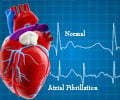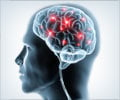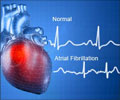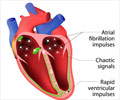Using digital medicine technologies researchers were able to identify undiagnosed atrial fibrillation in at-risk populations
- The rate of diagnosis of a hidden heart condition called atrial fibrillation (AFib), showed a threefold improvement in those actively monitored compared to usual care says study
- The first of its kind home-based clinical study was conducted in part by researchers at the Scripps Translational Science Institute
- AFib is an arrhythmia or an irregular heartbeat, which can increase the risk of stroke fivefold, in people who might have gone undiagnosed because of not showing symptoms
An FDA approved wireless iRhythm Zio®XT patch was used for ECG screening in the study that was conducted jointly by STSI researchers, Aetna's Healthagen Outcomes unit and Janssen Pharmaceuticals, Inc.
The findings of the mHealth Screening To Prevent Strokes (mSToPS) study were published in the Journal of the American Medical Association.
"Our study shows an almost threefold improvement in the rate of diagnosis of AFib in those actively monitored compared to usual care," says Steven Steinhubl, MD, director of digital medicine at STSI and an associate professor at The Scripps Research Institute (TSRI). "Timely diagnosis of AFib more effectively can enable the initiation of effective therapies and help reduce strokes and death."
Better screening will aid in detecting AFib
AFib is a kind of arrhythmia or irregular heartbeat that is a major risk factor for stroke and also doubles the risk of death. As many as six million Americans live with AFib. Once AFib has been diagnosed, the risk of stroke in individuals can be cut down with effective therapies. However, since a third of individuals with the disorder show no symptoms, and the lack of effective screening prevents or delays diagnosis and treatment, it becomes unavoidable sometimes to prevent stroke in people with AFib.Digital medicine technologies are innovative screening strategies that have the capability of making clinical research more inclusive and participant-centric. Novel mobile health (mHealth) devices monitor AFib more effectively and continuously without interfering with routine activities.
The primary objective of the mSToPS study was to determine whether asymptomatic AFib can be identified more efficiently than routine care using wearable sensor technology. The study compared outcomes of intermittent screening for AFib during regular visits to a primary care physician with continuous, single-lead electrocardiogram (ECG) monitoring using a patch sensor at home.
Home-based clinical research
The study population consisted of members of the American managed health care company, Aetna fully insured Commercial and Medicare health plans. Aetna's data sets were used to identify eligible members based on clinical characteristics associated with a possible increased incidence of AFib. The interested participants enrolled through a web-based digital consent process following a nationwide email outreach campaign.The advantage of the digital outreach and enrolment, and the home-based approach was that a person could participate in the study regardless of their geographical location.
A total of 5,214 individuals were included in the one-year analysis. One-third of them were assigned to the monitored cohort and the rest were observational controls. The monitored individuals received the wearable sensor by mail.
They self-applied the sensor and self-generated all the data (participant-generated).
The sensor was returned to iRhythm for analysis after two weeks of wearing the patch.
The generated data from the sensor was returned to the monitored participants and, then forwarded to their physicians after approval.
- AFib was newly diagnosed in 6.3 percent of the monitored participants and in 2.4 percent of the controls.
Clinical research should use more digital tools to make it more participant-focused and reflect the real world of those participants.
Atrial Fibrillation
Typically, the heart contracts and relaxes to a regular beat. Atrial fibrillation is the most common type of irregular heartbeat where the abnormal firing of electrical impulses causes the upper chambers of the heart to beat irregularly or quiver instead of beating effectively at a normal pace to move blood into the lower chambers.A person might be diagnosed with AFib only upon physical examination as the condition sometimes exhibits no symptoms. Some others might experience (apart from an irregular heartbeat), a fluttering or thumping in the chest, shortness of breath, faintness, fatigue (when exercising), dizziness, weakness, sweating or chest pain.
Many patients are unaware that AFib is a severe condition or that having AFib increases their risk for stroke or heart-related hospitalizations or death. In reality, AFib doubles the risk of heart-related deaths and is associated with a 5-fold increased risk for stroke.
A stroke results when a clot breaks off, enters the bloodstream and lodges in an artery that leads to the brain. About 15–20 percent of people who have strokes have AFib. Hence, treatment of the condition can save lives and lower risks. Patients diagnosed with this condition are put on blood thinners to prevent the occurrence of clots.
Reference:
- Treatment and Prevention of Atrial Fibrillation - (http://www.heart.org/HEARTORG/Conditions/Arrhythmia/AboutArrhythmia/Treatment-and-Prevention-of-Atrial-Fibrillation_UCM_423778_Article.jsp#.W0Rmj2AzaK4)
Source-Medindia














